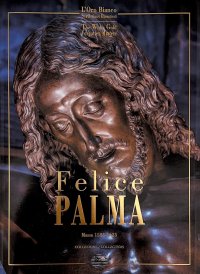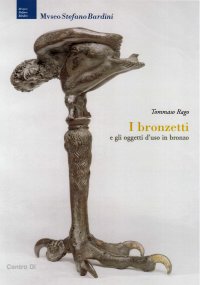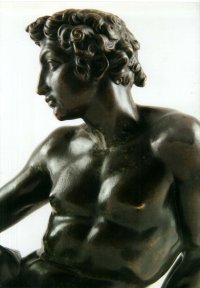Felice Palma. Massa 1583-1625. Collezione / Collection.
Texts by Andrei Cristina, Ciarlo Nicola, Federici Fabrizio, Claudio Casini and Sara Ragni.
Italian and English Text.
Pontedera, 2024; bound in a case, pp. 289, b/w and col. ill., b/w and col. plates, cm 24,5x34.
(L'Oro Bianco. Straordinari Dimenticati. The White Gold Forgotten Masters).
cover price: € 160.00
|
Books included in the offer:
Felice Palma. Massa 1583-1625. Collezione / Collection.
Texts by Andrei Cristina, Ciarlo Nicola, Federici Fabrizio, Claudio Casini and Sara Ragni.
Italian and English Text.
Pontedera, 2024; bound in a case, pp. 289, b/w and col. ill., b/w and col. plates, cm 24,5x34.
(L'Oro Bianco. Straordinari Dimenticati. The White Gold Forgotten Masters).
FREE (cover price: € 160.00)
Le botteghe del marmo
Italian and English Text.
Ospedaletto, 1992; bound, pp. 153, 10 b/w ill., 60 col. ill., cm 24x29.
(Immagine).
FREE (cover price: € 34.49)
Museo Stefano Bardini. I Bronzetti e gli Oggetti d'Uso in Bronzo
Edited by Nesi A.
Firenze, 2009; paperback, pp. 191, 102 b/w ill., 7 col. ill., cm 17x24,5.
(Museo Stefano Bardini).
FREE (cover price: € 30.00)
Bronzetti e Rilievi dal XV al XVIII Secolo
Bologna, 2015; 2 vols., bound in a case, pp. 729, ill., col. plates, cm 21,5x30,5.
FREE (cover price: € 90.00)
Jackson Pollock. The Figure of the Fury
Gruppo Editoriale Giunti
Edited by Campana Comparini F. and Risaliti S.
Firenze, Palazzo Vecchio, 16 aprile - 27 luglio 2014.
English Text.
Firenze, 2014; hardback, pp. 160, b/w and col. ill., cm 23,5x27.
(Cataloghi Mostre).
series: Cataloghi Mostre
Other editions available: Edizione Itlaliana (ISBN: 88-09-79480-X).
ISBN: 88-09-79481-8 - EAN13: 9788809794818
Subject: Collections,Essays (Art or Architecture),Monographs (Painting and Drawing),Painting
Period: 1800-1960 (XIX-XX) Modern Period
Extra: Impressionism/Expressionism
Languages: 
Weight: 0.88 kg
The exhibition is being held to celebrate the 450th anniversary of Michelangelo Buonarroti's death (he died in Rome on February 18, 1564) and it will take place in two locations: at the Palazzo Vecchio, which is home to Michelangelo's Genius of Victory statue in the Salone dei Cinquecento, where Pollock's drawings and paintings will be on display, and the former San Firenze courthouse, where the multimedia part of the exhibition will be set up, offering interactive and educational areas on the life and art of the painter.
The exhibition's curators Sergio Risaliti and Francesca Campana explain that Jackson Pollock is famous for having been the founder of action painting. His dripping has contrary effects, if not completely the opposite, to what was achieved by Buonarroti on the ceiling of the Sistine Chapel, where the artist was obliged to work according to the figurative and dogmatic doctrines of the time, although the painting was spread across the ceiling as if it were a horizontal level at an unreachable height and not on a canvas, placed vertically on an easel a short distance from the viewer and at an angle with the artist's body.
The worlds of the two artists do have a connection, however, in Pollock's younger studies, when the future star of 20th-century American painting was still undecided as to whether he wanted to become a painter or a sculptor. We know from documents housed at the Metropolitan Museum of Art New York that the young Pollock studied and reflected upon Michelangelo's work. There are sheets of paper bearing drawings by Pollock, Sketchbooks I and II, which reproduce the 'naked' in the Sistine Chapel, the Cumaean Sibyl and The Prophet Jonah, certain figures in the Flood, and even Adam in his famous position and studies of positions and drapery in the Judgement. Valuable information is revealed in an essay by Katharine Baetjer, published by the American museum in 1997, on the occasion of an exhibition dedicated to these important sketchbooks.
Exhibiting Pollock in Florence therefore has a truly epoch-making meaning, the curators emphasize. It is a moment to compare two worlds and two ages: one of which seems to be focused on the transcendence of the figure and on the sublimation of matter in body movement; the other on the phenomenology of formlessness and on the mystical geometry of chaos. Like Michelangelo, Pollock can be defined as a "universal artist" and, like the genial Florentine sculptor, he seems to have worked on every piece as if in a frenzy. "When I am 'in' my paintings, I am not fully aware of what I am doing," said Pollock, while Michelangelo stated in his poems, "I feel in me Love, almost as high as the Stars".

Out of Catalog











